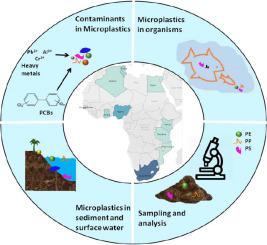Science of the Total Environment ( IF 9.8 ) Pub Date : 2020-09-21 , DOI: 10.1016/j.scitotenv.2020.142422 Olubukola S. Alimi , Oluniyi O. Fadare , Elvis D. Okoffo

|
Despite Africa ranking top in mismanaged plastic waste, there is insufficient data on the extent of microplastics and its interaction with other contaminants in its ecosystems. Microplastics pollution has been documented globally, however, specific data from the continent is crucial for accurate risk assessment and to drive policies. We critically reviewed 56 articles from 1987 to 2020 and provide an overview of the current knowledge of the abundance and distribution of microplastics and associated contaminants in African aquatic systems and organisms. Most of the studies were carried out in the marine environment and there is currently no available data on the abundance of microplastic pollution in the African terrestrial environment. We show that across all studies, 5–100% of all sampled aquatic organisms contained microplastics. Concerning high levels of microplastics were reported in fish from Egypt compared to other parts of Africa and the world. Across all persistent organic pollutants sampled in microplastics, hopanes and phthalates were present at high concentrations while sodium and zinc were high relative to other trace metals reported. The most frequently occurring plastics were polyethylene followed by polypropylene and polystyrene. We found that most of the studies relied on visual inspection (52%) > FTIR (38%) > Raman spectroscopy (5%) > Scanning electron microscopy (3%) > Differential scanning calorimetry (2%) for identifying microplastics. Major gaps in sampling and identification techniques which may have overestimated or underestimated the current levels were identified. We discuss other research priorities and recommend solutions to address these issues associated with microplastic pollution in Africa.
中文翻译:

非洲生态系统中的微塑料:当前的知识,数量,相关污染物,技术和研究需求
尽管非洲在处理不当的塑料废物中名列前茅,但关于微塑料的程度及其与生态系统中其他污染物的相互作用的数据却不足。全球已记录了微塑料污染,但是,来自非洲大陆的具体数据对于准确的风险评估和制定政策至关重要。我们严格审查了从1987年到2020年的56篇文章,并概述了有关非洲水生系统和生物中微塑料和相关污染物的丰富和分布的最新知识。大多数研究是在海洋环境中进行的,目前没有关于非洲陆地环境中大量微塑性污染的可用数据。我们表明,在所有研究中,所有采样的水生生物中有5–100%含有微塑料。据报道,与非洲和世界其他地区相比,埃及鱼类中的微量塑料含量较高。在微塑料中采样的所有持久性有机污染物中,hop烷和邻苯二甲酸盐均以高浓度存在,而钠和锌相对于其他痕量金属则较高。最常见的塑料是聚乙烯,其次是聚丙烯和聚苯乙烯。我们发现大多数研究依赖于目视检查(52%)> FTIR(38%)>拉曼光谱(5%)>扫描电子显微镜(3%)>差示扫描量热法(2%)来鉴定微塑料。确定了可能高估或低估了当前水平的抽样和鉴定技术方面的主要差距。



























 京公网安备 11010802027423号
京公网安备 11010802027423号